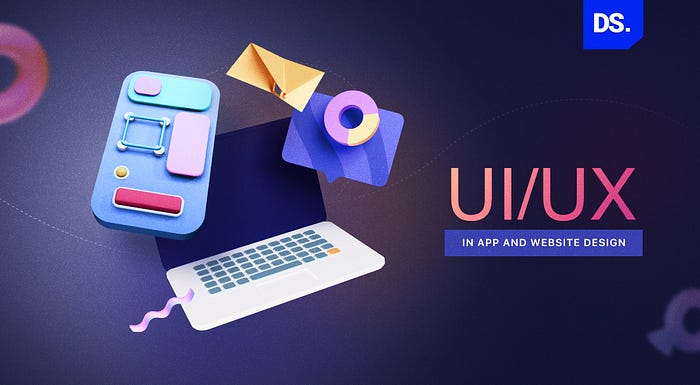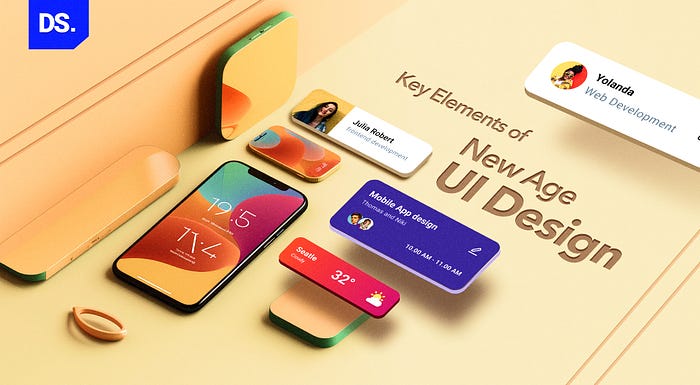

Importance of UI / UX Design in Today’s Digital World
source link: https://uxplanet.org/importance-of-ui-ux-design-in-todays-digital-world-da2b04b06635
Go to the source link to view the article. You can view the picture content, updated content and better typesetting reading experience. If the link is broken, please click the button below to view the snapshot at that time.

Importance of UI / UX Design in Today’s Digital World

Post-pandemic digital transformation has effectively turned most companies into tech companies. There were approximately 200+ million active websites in 2022. Most of them were business websites. Other brands have both websites and apps. The ones that don’t are actively planning to undergo digital transformations and invest in digital products.
User Experience (UX) designers and User Interface (UI) designers have key roles to play in facilitating these digital transformations. It’s the job of UX and UI designers to make their clients’ digital products intuitive and accessible to target users. How important is this job? Let’s look at some facts and figures:
In a recent study by Stanford Web, 75% of consumers claimed that they judge a brand’s credibility based on the quality of its website design. UX/UI design has a major impact on whether user experiences on a website are positive, enjoyable, and hassle-free.
In a survey by Qualtrics, 80% of the 1000+ surveyed customers claimed that they value customer experience above all other aspects of the technological products and services they purchase.
Google’s “ Page Experience “ algorithm is designed on a set of Core Web Vitals. UI/UX design and website speed are two essential factors in these Core Web Vitals. To rank high on Google, websites must offer super-fast website speed and high-quality UI/UX and website design.
Even in the world of apps, design is king. The best-performing apps in app stores like Instagram, Facebook, Candy Crush, amongst others, have all invested heavily in UI/UX design. That’s because most high-performing apps feature hundreds of in-app, micro-interactions. Properly designed UI/UX design elements make apps easier to explore and navigate through. From helping users open the app with minimum interference to offering them multiple payment options on the sales page: good UI/UX design practices have to be applied to every micro-interaction on every app page. Poorly designed micro-interactions on apps overwhelm users.
It’s undeniable that UI/UX design plays an instrumental role in winning over customers’ loyalty after every visit. But, why exactly are these design functions so crucial for attaining success in today’s digital world? Let’s dive into the nitty-gritty of UI/UX design and how these two fields shape our digital experiences.
UI/UX in App and Website Design in 2023

UX design is subjective. There is no single definition of good/bad UX design. With that being said, all UX design practices have the same objective: to make the interactions between users and digital products more pleasurable, efficient, and engaging.
UX in Website Design:
In website design, user experience is the measure of a user’s overall experience on the site from start to finish. Making the journey from the landing page to the end-action page — like, product or service order page — lag-free, convenient, and enjoyable is the main objective of website design professionals. This includes optimizing website speed, among other factors.
UX in App Design:
Mobile applications are challenging to design because of the limited surface area on phones. But they offer users many innovative interaction opportunities that websites can never match up to. A designer will optimize the end-to-end user experience of an app, making the user journey as intuitive and memorable as possible. All interactions that users have on apps are carefully curated and designed by UX designers.
Every app or website design project begins with discussions between the clients and the design team regarding design requirements. Accordingly, designers prepare a scope of work and decide on following a specific design approach. Here are the key stages of UX design that are followed:
User Behaviour Research:
Understanding the minds of target users is the key to learning how to engage them through digital design. So, research is a key part of UX design, especially in firms that exclusively practice data-driven UX design.
Information Structures:
This is the process of organizing all web and/or app content to make it convenient for users to access and explore.
Usability:
Designers employ different design techniques to guide users through different phases of using the app or website. This includes optimizing app or website speed and ensuring that there are no dead links between the digital product’s first and last phase, which is usually making purchases. Making these in-app micro-interactions as user-friendly as possible is the key to securing repeat visitors and keeping users browsing for longer periods.
Wireframing:
In this stage, designers determine the final flow of the app platform. Once the user flow is determined, the wireframe is created. This includes placing all the different design elements in the app or website in a clear, hierarchical order. Once the basic wireframe is created, designers create lo-fi prototypes of the product to further perfect its flow.
Interface Layouts and Page Hierarchy:
UX designers ensure all interface elements in their digital products are optimized to maximize user convenience.
User Interface design is also subjective. But, just like UX design, there are some fundamental objectives of UI design. Making digital products easier and more pleasurable to use by improving their aesthetics, responsiveness, speed, efficiency and accessibility is the fundamental objective of UI design in both websites and applications.
UI designers ensure that the website or application design reflects the brand’s essence and resonates with the target user’s emotions. They maintain a sense of design consistency throughout the platform that they are designing. This consistency ensures that their target users can easily recognize specific design elements and perform specific actions. In addition to guiding users to take specific actions via efficient design language, UI designers also give their digital products appealing interfaces. This appeal is fashioned through the use of brand colors, eye-catching graphics, animations, and other interactive design elements.
Key Elements of New-age UI Design

Strategy:
UI design projects start off by assessing user needs, pain points, and the company’s business objectives. Based on these assessments, clear design strategies, user personas, story maps, brand stories, and other necessary aspects are designed.
Scoping:
Scoping is the process of ensuring that all interface functionalities in the website or app fulfill important business objectives. For instance, a smart UI designer can turn a dull and empty page into an engaging one by adding interactive elements like checkboxes, drop-down lists, call-to-action buttons or text fields, as required. All of these design elements aren’t just eye candy. They serve business-specific functions. A couple of common examples would be collecting data through text fields and encouraging users to make purchases through eye-catching and strategically-placed CTA buttons.
Structure:
Here, UI designers translate UX research into deliverables. They enhance their app or website’s visibility by aligning the interface design with predicted customer behaviors and flows. Interaction design and information architecture are two key parts of structure design in UI.
Creating a Consistent User Design:
Designers ensure that the website or app’s color palette, typography, and other visual elements are consistent with the end user’s expectations. They also align user design with the brand image the company is trying to portray.
10 Certified Benefits of UI/UX Design

Now that we’ve examined the intricacies of UI/UX design, let’s move on to some certified benefits that businesses receive when they invest in UI/UX design:
I. Increased Conversion Rates:
Improved user experience which leads to increased user satisfaction and engagement rates. These effects ultimately result in increased conversion rates for the business.
II. Higher User Retention:
Digital products with good UI/UX design retain users for longer periods, encouraging them to interact with more content.
III. Customer Loyalty:
Higher user retention directly translates to increased loyalty. The same applies to convenient user experiences.
IV. Increased Return on Investment (ROI):
In the long-run investments in UI/UX design translate into improved conversion rates, brand loyalty and lead acquisition. These returns ultimately far outweigh the initial investments.
V. Establishing Brand Consistency:
Businesses that maintain brand consistency in their digital products’ designs boost their credibility and popularity.
VI. Higher Rate of User Growth:
A core aspect of UI/UX design is attending to the needs of target users. With such a foundational principle, digital products are guaranteed to pique the interests of more and more customers every year.
VII. Increased In-House Productivity:
A streamlined and well-designed website or application can have a positive impact on a company’s staff. Intuitive UI/UX designs in websites and apps help create smooth workflows for employees.
VIII. Search Engine Optimization Boost:
As stated before UI/UX design is a central aspect of Google’s Core Web Vital. Investing in the right UI/UX design practices can certainly help websites improve their SERP rankings.
IX. Avoiding Future Design Hassles:
Adopting a clear UI/UX design strategy from the start helps businesses address usability issues long before they negatively impact user experiences. Such an approach also helps businesses avoid extra re-design and correction costs in the future.
X. Delivering Good User Experiences on All Devices and Platforms:
If you want your brand’s digital products to deliver optimal user experiences on all devices: phones, desktops, and tablets, you will need to ensure that they are optimized for those devices. UI/UX designers help brands achieve this objective by establishing design and interface uniformity across platforms and versions of their customers’ digital products.
Mixing Intuitive and Data-Driven UI/UX Design

At the best UI/UX design agencies, design professionals from different fields and backgrounds streamline their finest ideas. These ideas undergo multiple layers of internal feedback until they’re finally deemed good enough to meet stakeholder expectations. Such intricate practices elevate the quality of the UI/UX design services these agencies provide.
That’s why, the digital products of brands that invest in professional UI/UX design services always stand out. Any organization that doesn’t meet these high standards of UI/UX design, is guaranteed to fail in this current digital market.
So, if you want your digital products to satisfy, engage, and retain your target customers, investing in UI/UX design services is a must. Every other business is doing it and the ones that aren’t will be left out.
Recommend
About Joyk
Aggregate valuable and interesting links.
Joyk means Joy of geeK